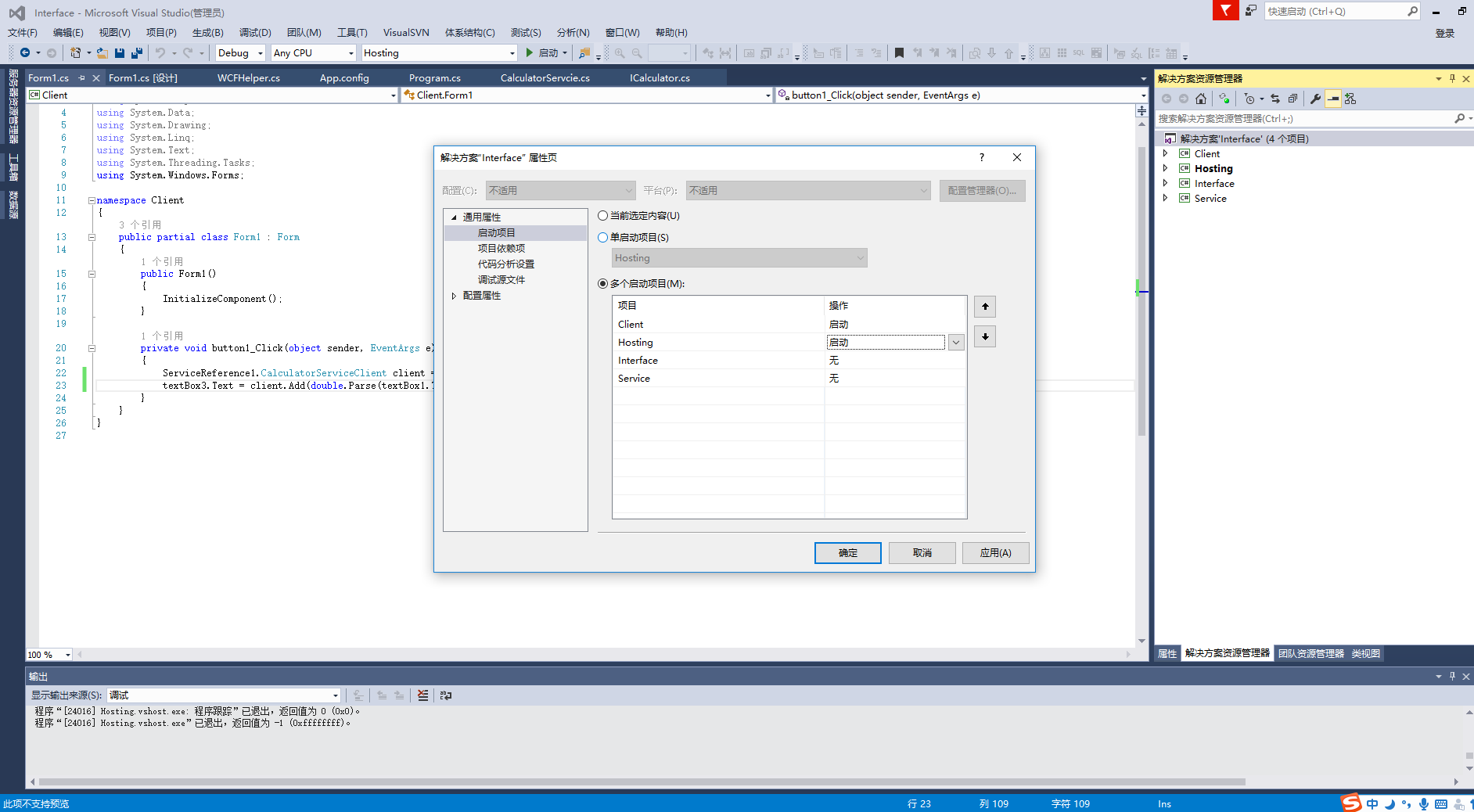WCF本质上提供一个跨进程、跨机器以致跨网络的服务调用 ,本示例中 主要实现了计算器的功能,大部分的函数来源于网上别人的帖子,这叫站在巨人的肩膀上,O(∩_∩)O哈哈~,但是为了加深自己的对wcf的理解,因此决定自己在写个类似的demo,把写demo中遇到的问题展现出来,我相信对于初识wcf的程序员了来说,也会遇到各种问题。好了步入正题。
WCF 分为四个部分 1、契约(Interface)2、服务契约(Service)3、WCF 宿主程序(控制台或者IIS) 4、客户端(Client)
本人在写wcf的时候喜欢将四个部分分别拆分成不同的类库来管理。
1、契约
契约是对外开放的接口,暴露给客户端的函数名称首先,新建一个wcf服务库,名称为Interface,如图所示:
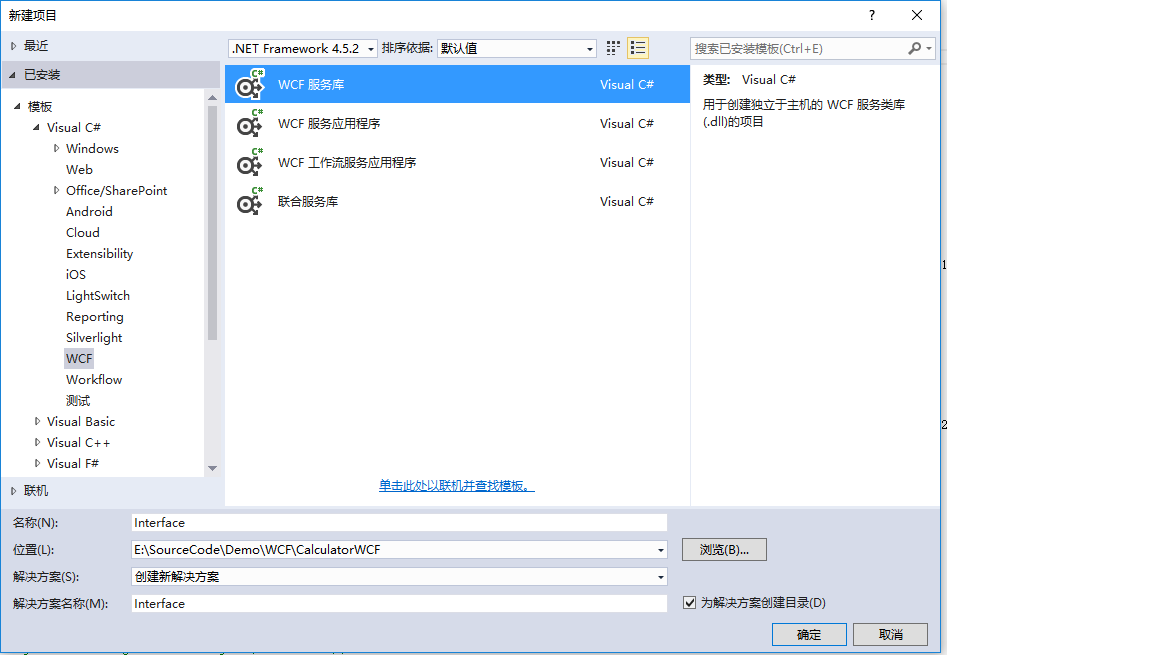
删掉程序中默认的文件(App.config,IService1.cs,Service1.cs),新建ICalculator
namespace Interface { [ServiceContract(Name = "CalculatorService", Namespace = "http://www.artech.com/")] public interface ICalculator { [OperationContract] double Add(double x, double y); [OperationContract] double Subtract(double x, double y); [OperationContract] double Multiply(double x, double y); [OperationContract] double Divide(double x, double y); } }
2、新建服务契约,其实就是实现契约的类 ,添加"新建项目"->WCF->"WCF服务库" (如 第一步新建契约是一样的步骤),类库的名称为Service,
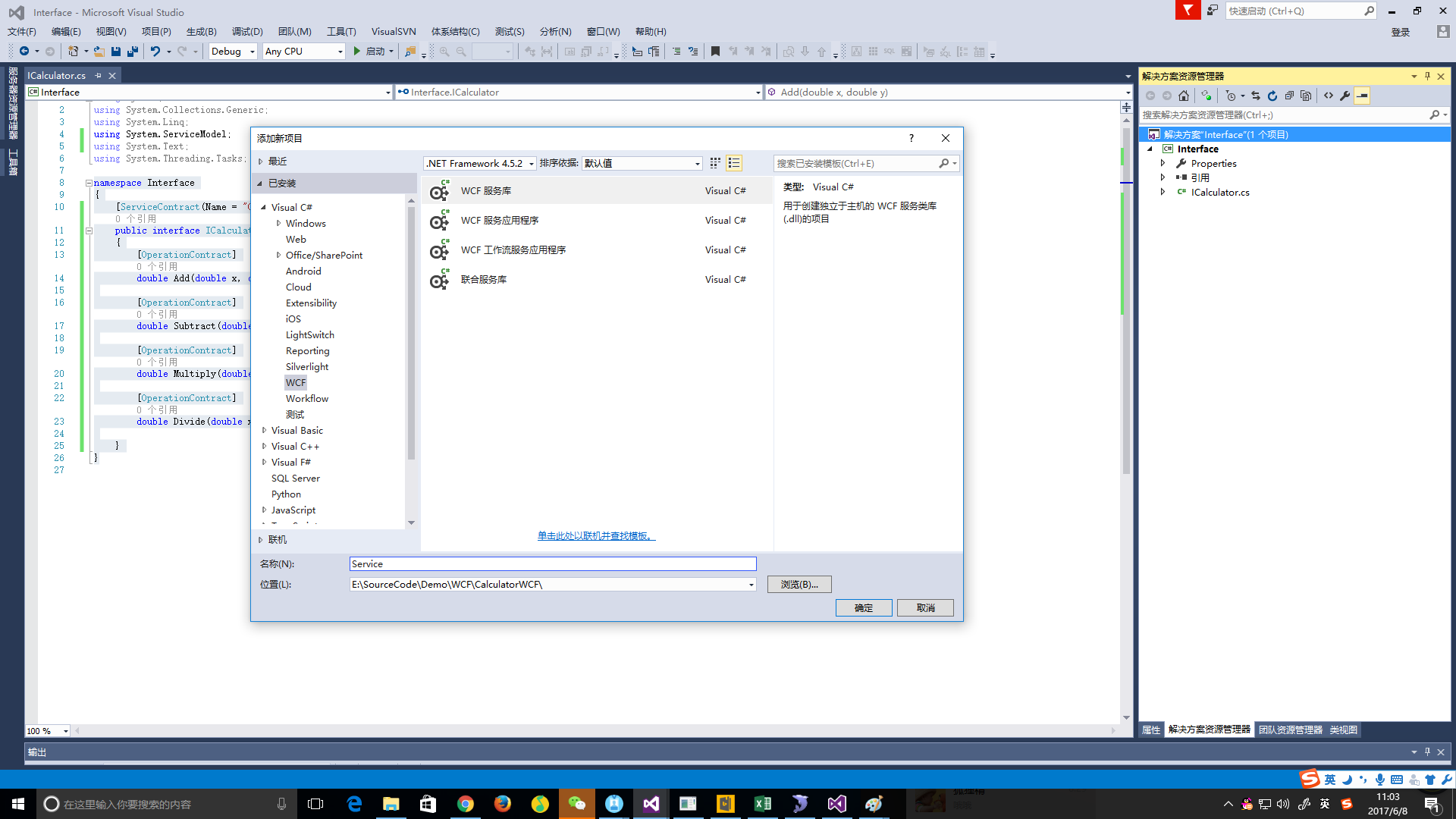
新建成功后,删除默认文件(App.config,IService1.cs,Service1.cs),添加引用"Interface" 类库,新建CalculatorService 并实现ICalculator
namespace Service { [ServiceBehavior(InstanceContextMode = InstanceContextMode.PerCall, ConcurrencyMode = ConcurrencyMode.Multiple)] public class CalculatorService : ICalculator { public double Add(double x, double y) { return x + y; } public double Subtract(double x, double y) { return x - y; } public double Multiply(double x, double y) { return x * y; } public double Divide(double x, double y) { return x / y; } }
3、新建WCF宿主程序,WCF的契约和服务契约都已经建完,但是还需要一个程序来承载这些接口供外部程序调用,因此称之为宿主程序,宿主程序可以部署在IIS上,也可以用控制台程序运行方便调试,下面我就介绍用控制台程序作为宿主程序。在解决方案的名称右键添加"控制台程序" 名称为Hosting ,添加对Interface和Service的引用
实现wcf对外开放有两种方式,一种方式是配置文件,将所有的WCF信息都写到配置文件中
第一种:WCF的相关信息写到配置文件(App.config)中
<?xml version="1.0" encoding="utf-8"?> <configuration> <startup> <supportedRuntime version="v4.0" sku=".NETFramework,Version=v4.6.1"/> </startup> <system.serviceModel> <services> <service name="Service.CalculatorService" behaviorConfiguration="WCFService.WCFServiceBehavior"> <endpoint address="http://127.0.0.1:8888/CalculatorService" binding="wsHttpBinding" contract="Service.Interface.ICalculator"> </endpoint> <endpoint address="net.tcp://127.0.0.1:9999/CalculatorService" binding="netTcpBinding" contract="Service.Interface.ICalculator"> </endpoint> <endpoint address="mex" binding="mexHttpBinding" contract="IMetadataExchange" /> <endpoint address="mex" binding="mexTcpBinding" contract="IMetadataExchange" /> <host> <baseAddresses> <add baseAddress="http://127.0.0.1:8888/"/> <add baseAddress="net.tcp://127.0.0.1:9999/"/> </baseAddresses> </host> </service> </services> <behaviors> <serviceBehaviors> <behavior name="WCFService.WCFServiceBehavior"> <serviceMetadata httpGetEnabled="true" /> <serviceDebug includeExceptionDetailInFaults="false" /> </behavior> </serviceBehaviors> </behaviors> </system.serviceModel> </configuration>
Main方法的主要代码如下,
public class Program { internal static ServiceHost host = null; static void Main(string[] args) { using (ServiceHost host = new ServiceHost(typeof(CalculatorService))) { host.Opened += delegate { Console.WriteLine("CalculaorService已经启动,按任意键终止服务!"); }; host.Open(); Console.ReadLine(); } } }
运行控制台程序,如下图所示:
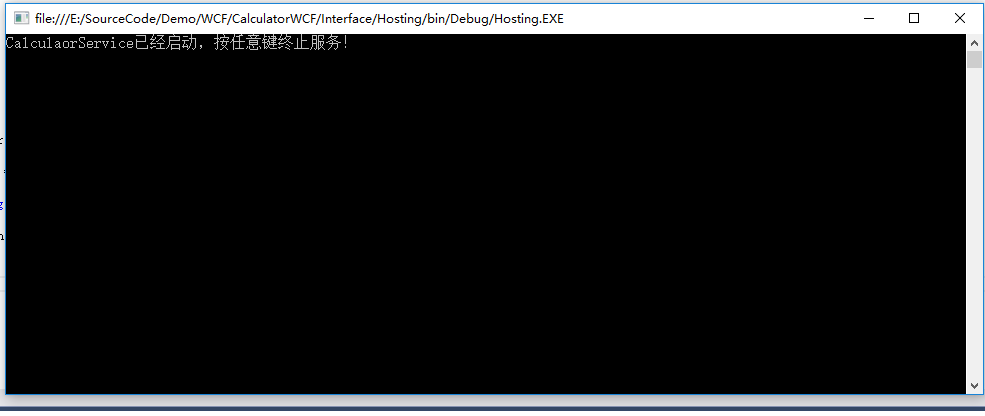
第二种:写一个WCFHelper类,添加帮助类的时候,一定引用System.Runtime.Serialization ,并且删掉App.config 对wcf的配置,否则会报错代码如下:
public static class WCFHelper { public static string IP { get; set; } public static int Port { get; set; } static WCFHelper() { try { IP = System.Environment.MachineName;// ConfigurationManager.AppSettings["ServiceIP"];// Port = int.Parse(ConfigurationManager.AppSettings["ServicePort"]); } catch { } EndpointAddress.Add(BindingProtocol.Http, "http://{0}:{1}/{2}/{3}"); EndpointAddress.Add(BindingProtocol.NetTcp, "net.tcp://{0}:{1}/{2}/{3}"); //EndpointAddress.Add(BindingProtocol.NetMsmq, "net.msmq://{0}:{1}/" + schema + "/{2}"); //EndpointAddress.Add(BindingProtocol.NetPipe, "net.pipe://{0}:{1}/" + schema + "/{2}"); try { httpBinding = new BasicHttpBinding(); httpBinding.MaxBufferSize = 200065536; httpBinding.MaxReceivedMessageSize = 200065536; httpBinding.CloseTimeout = new TimeSpan(0, 10, 0); httpBinding.OpenTimeout = new TimeSpan(0, 10, 0); httpBinding.ReceiveTimeout = new TimeSpan(0, 10, 0); httpBinding.SendTimeout = new TimeSpan(0, 1, 0); httpBinding.Security.Mode = BasicHttpSecurityMode.None; httpBinding.ReaderQuotas.MaxDepth = 64; httpBinding.ReaderQuotas.MaxStringContentLength = 2147483647; httpBinding.ReaderQuotas.MaxArrayLength = 16384; httpBinding.ReaderQuotas.MaxBytesPerRead = 4096; httpBinding.ReaderQuotas.MaxNameTableCharCount = 16384; } catch { httpBinding = new BasicHttpBinding(); } try { tcpBinding = new NetTcpBinding(); tcpBinding.CloseTimeout = new TimeSpan(0, 1, 0); tcpBinding.OpenTimeout = new TimeSpan(0, 1, 0); tcpBinding.ReceiveTimeout = new TimeSpan(0, 10, 0); tcpBinding.SendTimeout = new TimeSpan(0, 1, 0); tcpBinding.TransactionFlow = false; tcpBinding.TransferMode = TransferMode.Buffered; tcpBinding.TransactionProtocol = TransactionProtocol.OleTransactions; tcpBinding.HostNameComparisonMode = HostNameComparisonMode.StrongWildcard; tcpBinding.ListenBacklog = 100000; tcpBinding.MaxBufferPoolSize = 524288; tcpBinding.MaxBufferSize = 200065536; tcpBinding.MaxConnections = 2000; tcpBinding.MaxReceivedMessageSize = 200065536; tcpBinding.PortSharingEnabled = true; tcpBinding.Security.Mode = SecurityMode.None; tcpBinding.ReaderQuotas.MaxDepth = 64; tcpBinding.ReaderQuotas.MaxStringContentLength = 2147483647; tcpBinding.ReaderQuotas.MaxArrayLength = 163840000; tcpBinding.ReaderQuotas.MaxBytesPerRead = 4096; tcpBinding.ReaderQuotas.MaxNameTableCharCount = 16384; tcpBinding.ReliableSession.Ordered = true; tcpBinding.ReliableSession.InactivityTimeout = new TimeSpan(0, 10, 0); tcpBinding.ReliableSession.Enabled = false; } catch { tcpBinding = new NetTcpBinding(); } } private static BasicHttpBinding httpBinding; public static BasicHttpBinding HttpBinding { get { return httpBinding; } } private static NetTcpBinding tcpBinding; public static NetTcpBinding TcpBinding { get { return tcpBinding; } } public static EndpointAddress GetEndpointAddress(string ip, int port, string serviceSchema, string serviceName, BindingProtocol protocol) { string address = EndpointAddress[protocol]; address = string.Format(address, ip, port, serviceSchema, serviceName); return new EndpointAddress(address); } public static EndpointAddress GetEndpointAddress(string serviceSchema, string serviceName, BindingProtocol protocol) { string address = EndpointAddress[protocol]; address = string.Format(address, IP, Port, serviceSchema, serviceName); return new EndpointAddress(address); } public static Uri GetBaseAddress(string ip, int port, string serviceSchema, string serviceName, BindingProtocol protocol) { string address = EndpointAddress[protocol]; address = string.Format(address, ip, port + 1, serviceSchema, serviceName); return new Uri(address); } public static Uri GetBaseAddress(string serviceSchema, string serviceName, BindingProtocol protocol) { string address = EndpointAddress[protocol]; address = string.Format(address, IP, Port + 1, serviceSchema, serviceName); return new Uri(address); } private readonly static Dictionary<BindingProtocol, string> EndpointAddress = new Dictionary<BindingProtocol, string>(); public enum BindingProtocol { Http = 1, NetTcp = 2, //NetPipe = 3, //NetMsmq = 4 } }
将 宿主程序中的main方法改成如下:
static void Main(string[] args) { WCFHelper.IP = "127.0.0.10"; WCFHelper.Port = 9999; Uri httpUri = WCFHelper.GetBaseAddress(WCFHelper.IP, WCFHelper.Port, "Calculator", "Inspect", WCFHelper.BindingProtocol.Http); using (ServiceHost host = new ServiceHost(typeof(CalculatorService), httpUri)) { host.AddServiceEndpoint(typeof(ICalculator), WCFHelper.TcpBinding, WCFHelper.GetEndpointAddress(WCFHelper.IP, WCFHelper.Port, "Calculator", "InspectService", WCFHelper.BindingProtocol.NetTcp).Uri.AbsoluteUri); ServiceMetadataBehavior behavior = new ServiceMetadataBehavior(); #if DEBUG behavior.HttpGetEnabled = true; #else behavior.HttpGetEnabled = false; #endif host.Description.Behaviors.Add(behavior); host.Opened += delegate { Console.WriteLine("CalculaorService已经启动,按任意键终止服务!"); }; host.Open(); Console.ReadLine(); } }
4、宿主程序建完了,WCF的所有锲约已经对外可以访问了,那现在需要建立Client 去调用wcf程序了 ,
首先,编译宿主程序Host,找到bin/debug/ Host.exe 右键管理员打开,如果如下图证明服务已经于宁

其次,在解决方案名称->右键添加Winform程序 新建WinForm 程序,添加"服务引用"
添加服务引用 (此引用方式,是以"3、添加宿主程序" ->"第二种 WCF帮助类的方式")


点击“转到” 系统发现WCF服务,如下图所示:
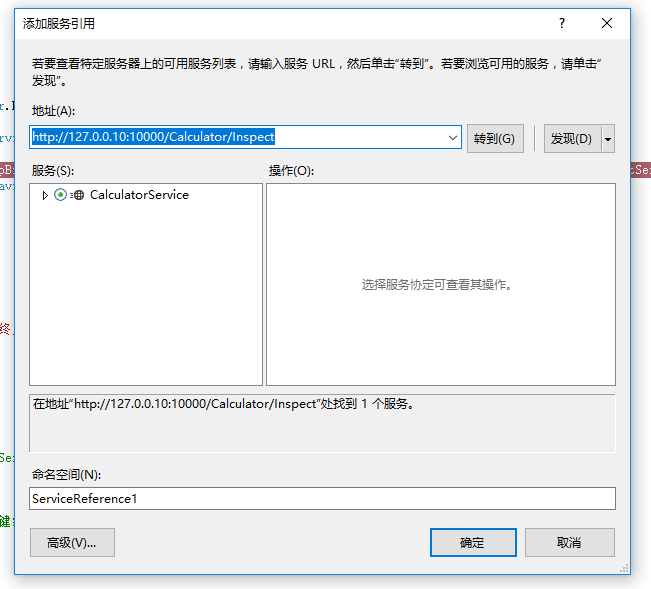
点击确定,就成功的将wcf的引用了,下面开始调用WCF的程序了,例如调用Add方法,代码如下:
ServiceReference1.CalculatorServiceClient client = new ServiceReference1.CalculatorServiceClient(); textBox3.Text = client.Add(double.Parse(textBox1.Text), double.Parse(textBox2.Text)).ToString();
到此为止,wcf程序已经完成的跑通了,记得 调试的时候已经把宿主程序和client程序同时运行。
如果闲麻烦,vs 支持同时启动多个项目,可以同时把client 和host同时启动
